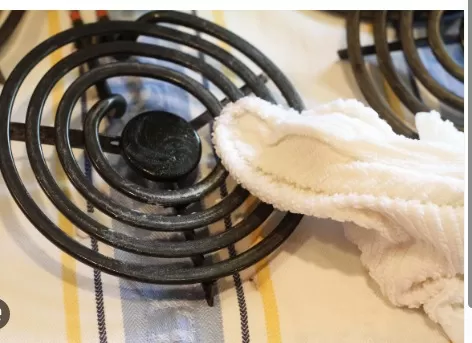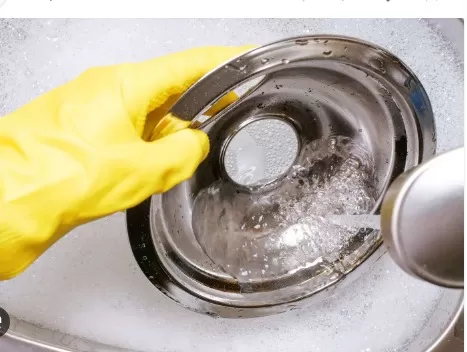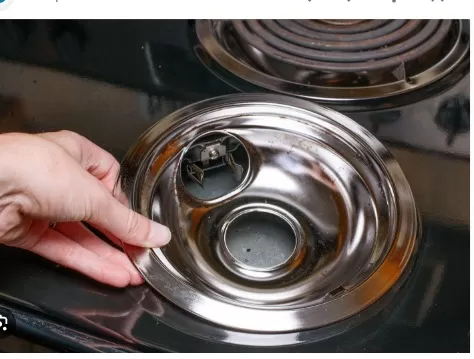Stove Drip Pan Cleaning: DIY Tips Using Kitchen Staples. If you’re dealing with caked-on food and stubborn messes on your stove drip pans, there are two effective methods you can try to banish the grime. The first method involves soaking the drip pans in a mixture of hot water and Dish Soap, allowing the grime to loosen before scrubbing them clean.
The second method involves using a paste made from baking soda and water, which you can apply to the drip pans and let sit for a while before scrubbing away the built-up residue. By utilizing these cleaning techniques, you can restore your stove drip pans to their original cleanliness and keep your kitchen looking fresh and tidy.
Essential Tips for Cleaning Stove Drip Pans

Cleaning stove drip pans is an important task to maintain the cleanliness and efficiency of your stove.
However, before you begin the cleaning process, it’s crucial to ensure that the drip pans have cooled down to room temperature. This precautionary step will prevent any accidental burns while cleaning.
Removing the Drip Pans: To clean the drip pans, you first need to remove the coils or grates that are placed on top of them.
If you have an electric stove, gently lift one side of the burner coil to reveal the socket where it is plugged in. Carefully pull the coil out of the socket and set it aside.
Once the coil is removed, you can easily lift out the drip pan.
For gas stoves, you’ll find metal grates that can be lifted off to provide access to the drip pan beneath.
Cleaning Techniques: Regardless of whether your stove has electric or gas burners, and whether the drip pans are made of chrome or porcelain, the following cleaning techniques will effectively remove grime and restore their cleanliness:.
Soaking: Fill a sink or basin with warm water and add a small amount of dish soap or a mild cleaning solution.
Submerge the drip pans in the soapy water and let them soak for about 30 minutes. This will help loosen the dirt and grease.
Scrubbing: After soaking, use a sponge or a soft brush to scrub away the loosened grime.
For stubborn stains, you can create a paste by mixing baking soda and water and apply it to the affected areas. Gently scrub until the stains are removed.
Rinsing and Drying: Once the drip pans are clean, rinse them thoroughly with water to remove any remaining soap or cleaning solution.
Ensure that all the residue is washed away. After rinsing, dry the drip pans completely before placing them back in the stove.
Quick and Effective Method for Cleaning Stove Drip Pans with Baking Soda and Dish Soap

Need to clean your stove drip pans in a hurry? This speedy method using baking soda and dish soap will have your drip pans sparkling clean in no time.
With just a few simple steps, you’ll be ready to cook on a clean stovetop in a matter of hours.
Supplies Needed:.
Trash can
Bowl
Liquid dish soap
Baking soda
Pastry brush (optional)
Sponge
Rag
Dishcloth
Scrub brush
Step 1: Remove and Rinse the Drip Pans: Take out the cooled drip pans from the stovetop, shake off any loose crumbs into the trash can, and thoroughly rinse the pans with hot water in the sink.
Step 2: Prepare the Cleaning Solution: In a small bowl, mix equal parts of liquid dish soap and baking soda.
Start with half a cup of each and adjust the quantities as needed.
Step 3: Apply the Mixture to the Drip Pans: Generously coat each drip pan with the soap and baking soda mixture.
Use your fingers or a pastry brush to scrub the mixture into the pans, loosening any stuck-on grime.
Step 4: Allow the Soapy Drip Pans to Sit: Stack the coated drip pans in the sink and let them sit for approximately an hour.
While waiting, use a damp sponge dipped in baking soda to scrub the rest of your stovetop. Wipe off the baking soda with a clean damp rag and dry the stove with a soft dishcloth.
Step 5: Rinse and Scrub if Necessary: Thoroughly rinse the drip pans with hot water to remove the soap mixture.
For any remaining dirty spots, use a scrub brush or a sponge dipped in baking soda to tackle them.
Step 6: Dry and Replace the Drip Pans: Dry the drip pans with a dish towel and place them back on the stovetop.
Put the burners back in their positions, and enjoy cooking on your newly cleaned stovetop!.
.
Efficient Grease-Cutting Method for Cleaning Stove Drip Pans with Ammonia

If you’re looking for a highly effective method that requires minimal scrubbing, using ammonia to clean your stove drip pans is the way to go.
By following these steps and allowing for ample soaking time, you can effortlessly remove grease and grime from your drip pans. Implement this method after dinner to wake up to a spotless stovetop the next day.
Supplies Needed:.
1-gallon ziplock bags
Household ammonia
Sponge
Liquid dish soap
Dish towel
Step 1: Prepare the Drip Pans: Once your drip pans have cooled down after dinner, remove them from the stovetop and rinse them with hot water.
Place each drip pan in its own 1-gallon ziplock bag.
Step 2: Add the Ammonia Solution: Add 1/4 cup of household ammonia to each ziplock bag.
It’s not necessary to fully coat the drip pans with ammonia as the fumes will work to loosen burnt-on food splatter.
Step 3: Soak the Drip Pans Overnight: Seal the ziplock bags and stack them in your empty kitchen sink.
Leave them to soak overnight or for at least 12 hours. Ensure that the area is well-ventilated due to the strong ammonia fumes.
Step 4: Remove Drip Pans and Dispose of the Solution: In a well-ventilated area, open the bags and remove the drip pans.
Dispose of the used bags appropriately. Dilute the ammonia solution with cold water and pour it down the Sink Drain, taking care to neutralize it if you have a septic system.
Step 5: Rinse and Scrub as Needed: If any spots remain on the drip pans, use a sponge and dish soap to wipe them away.
Little to no scrubbing should be required. Thoroughly rinse the drip pans with hot water.
Step 6: Dry and Replace the Drip Pans: Dry the drip pans with a towel and place them back on the stovetop.
Enjoy the satisfaction of having a pristine and grease-free kitchen appliance.
Proactive Tip: To minimize future cleaning efforts, clean up any messes promptly during and after cooking.
Take note of spills and splatters, and wipe the drip pans clean of grease, dust, and food remnants as soon as they cool down after each meal.
.
Final Thoughts
Cleaning stove drip pans is an essential task to maintain a clean and well-functioning kitchen.
Whether you opt for the faster method using baking soda or the slower method with ammonia, both approaches will result in clean and improved-looking drip pans. Remember to wipe away spills and drips after each cooking session to keep your drip pans in top condition. It’s also recommended to thoroughly clean your stovetop, including the drip pans, at least once a month or more frequently if needed.
FAQs About Cleaning Drip Pans:.
Q: Is cleaning drip pans difficult? A: Cleaning drip pans can be a bit tedious, but it’s not a difficult task.
Following the outlined procedures should help you through the process effectively.
Q: How often should I clean my drip pans? A: It’s recommended to clean your drip pans thoroughly at least once a month.
However, if you cook frequently or tend to make dishes that splatter or splash, more frequent cleaning may be necessary.
Q: Can I use other Cleaning Solutions or methods? A: The suggested methods using baking soda or ammonia are highly effective for cleaning drip pans.
However, you can explore other cleaning solutions or methods if you prefer, but ensure they are safe for the material of your drip pans and follow the manufacturer’s guidelines.
Q: Are there any additional tips for maintaining drip pans? A: Along with regular cleaning, it’s important to avoid using abrasive cleaners or scrub brushes that could damage the surface of the drip pans.
Additionally, letting your stove cool down before touching the surface is crucial to prevent burns.
By following these guidelines and taking proper care of your drip pans, you can ensure a clean and well-maintained kitchen, making your cooking experiences more enjoyable.
*The information is for reference only.